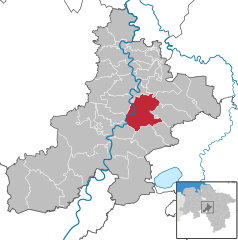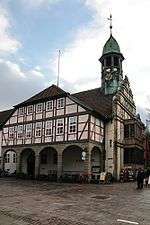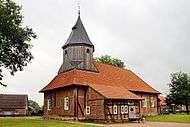Nienburg, Lower Saxony
| Nienburg | ||
|---|---|---|
| ||
 Nienburg | ||
Location of Nienburg within Nienburg district 
 | ||
| Coordinates: 52°38′28″N 9°12′25″E / 52.64111°N 9.20694°ECoordinates: 52°38′28″N 9°12′25″E / 52.64111°N 9.20694°E | ||
| Country | Germany | |
| State | Lower Saxony | |
| District | Nienburg | |
| Government | ||
| • Mayor | Henning Onkes (Ind.) | |
| Area | ||
| • Total | 64.45 km2 (24.88 sq mi) | |
| Population (2015-12-31)[1] | ||
| • Total | 31,193 | |
| • Density | 480/km2 (1,300/sq mi) | |
| Time zone | CET/CEST (UTC+1/+2) | |
| Postal codes | 31582 | |
| Dialling codes | 05021 | |
| Vehicle registration | NI | |
| Website | www.nienburg.de | |
Nienburg (official name: Nienburg/Weser) (Low German: Nienborg, Neenborg or Negenborg) is a town and capital of the district Nienburg, in Lower Saxony, Germany.
Geography
Situated on the scenic German Timber-Frame Road, Nienburg lies on the river Weser, approximately 55 km (34 mi) southeast of Bremen, and 45 km (28 mi) northwest of Hanover. Nienburg is the largest town in the Middle Weser Region.
Demography
| Year | 1987 | 1992 | 1997 | 1998 | 1999 | 2000 | 2001 | 2002 | 2003 | 2004 | 2005 | 2006 | 2007 | 2008 | 2009 | 2010 | 2011 |
|---|---|---|---|---|---|---|---|---|---|---|---|---|---|---|---|---|---|
| Population | 29.427 | 31.444 | 32.837 | 32.789 | 32.659 | 32.611 | 32.454 | 32.462 | 32.543 | 32.691 | 32.803 | 32.764 | 32.384 | 32.205 | 32.152 | 31.924 | 31.862 |
(as of Dec. 31st)[2]
 |


Structure
Nienburg, including quarters
- Erichshagen
- Holtorf
- Langendamm
- Schäferhof/Kattriede
- Nordertor
- Leintor
- Lehmwandlung
- Alpheide
History
The major reason for the emergence and development of Nienburg into the largest city in the Middle Weser region was its location at a convenient ford in the Weser River, leading to multiple trade routes radiating from the location. As early as 1025 the location was referred to as Negenborg, i.e. New Castle. In 1215 it began to be referred to as a city, a civitas, when Count Henry I of Hoya began the residence of his ruling line. From 1582 until 1866 the Guelph (Welf) Dukes of Brunswick-Lüneburg controlled the county, except for Napoleonic French rule from 1803 to 1813.[3]
The former suburb Wölpe refers to Grafen (earl) von Wölpe and the associated castle.
Politics
Mayor
The mayor is Henning Onkes (independent). He was reelected in 2014 against three competitors.[4]
Local council (Stadtrat)
The 38 members of the "Stadtrat" are divided among:
- CDU: 13, among them the second deputy mayor Wilhelm Schlemermeyer
- SPD:14, among them the first deputy mayor Rolf Warnecke
- Alliance '90/The Greens: 6, among them the third deputy mayor Hedda Freese
- FDP: 1
- Wählergemeinschaft - Independent Union of Citizens WG 3
- The Left (Germany): 1
- One additional vote by the elected mayor of Nienburg, Mr. Henning Onkes, who doesn't belong to any political party
International relations
Nienburg, Lower Saxony is twinned with:
-
.svg.png) Belgium: Dendermonde
Belgium: Dendermonde -
 United States: Las Cruces, New Mexico
United States: Las Cruces, New Mexico -
 Belarus: Vitebsk
Belarus: Vitebsk -
 Poland: Bartoszyce (formerly "Bartenstein")
Poland: Bartoszyce (formerly "Bartenstein") -
 Germany: Nienburg (Saale)
Germany: Nienburg (Saale)
Sons and daughters of the town
- Heinrich Lübbe (1884–1940), mechanical engineering
- Lutz Meyer-Gossner (born 1936), judge at the Federal Court from 1983 to 2001
- Volker Finke (born 1948), football coach (16 years FC Freiburg)
- Susanne Schröter (born 1957), professor of ethnology
- Carsten Sieling (born 1959), German politician, mayor and president of the senate of the Free Hanseatic City of Bremen (SPD)
- Maja Maranow (1961–2016), actress
- Levent Ayçiçek (born 1994), football player
See also
References
- ↑ Landesbetrieb für Statistik und Kommunikationstechnologie Niedersachsen, 102 Bevölkerung - Basis Zensus 2011, Stand 31. Dezember 2015 (Tabelle K1020014)
- ↑ LSKN-Online
- ↑ https://www.nienburg.de
- ↑ http://www.landeswahlleiter.niedersachsen.de/download/87577/Einzelergebnisse_der_Direktwahlen_am_25._Mai_2014.pdf Einzelergebnisse der Direktwahlen am 25. Mai 2014 in Niedersachsen], abgerufen am 14. November 2014
